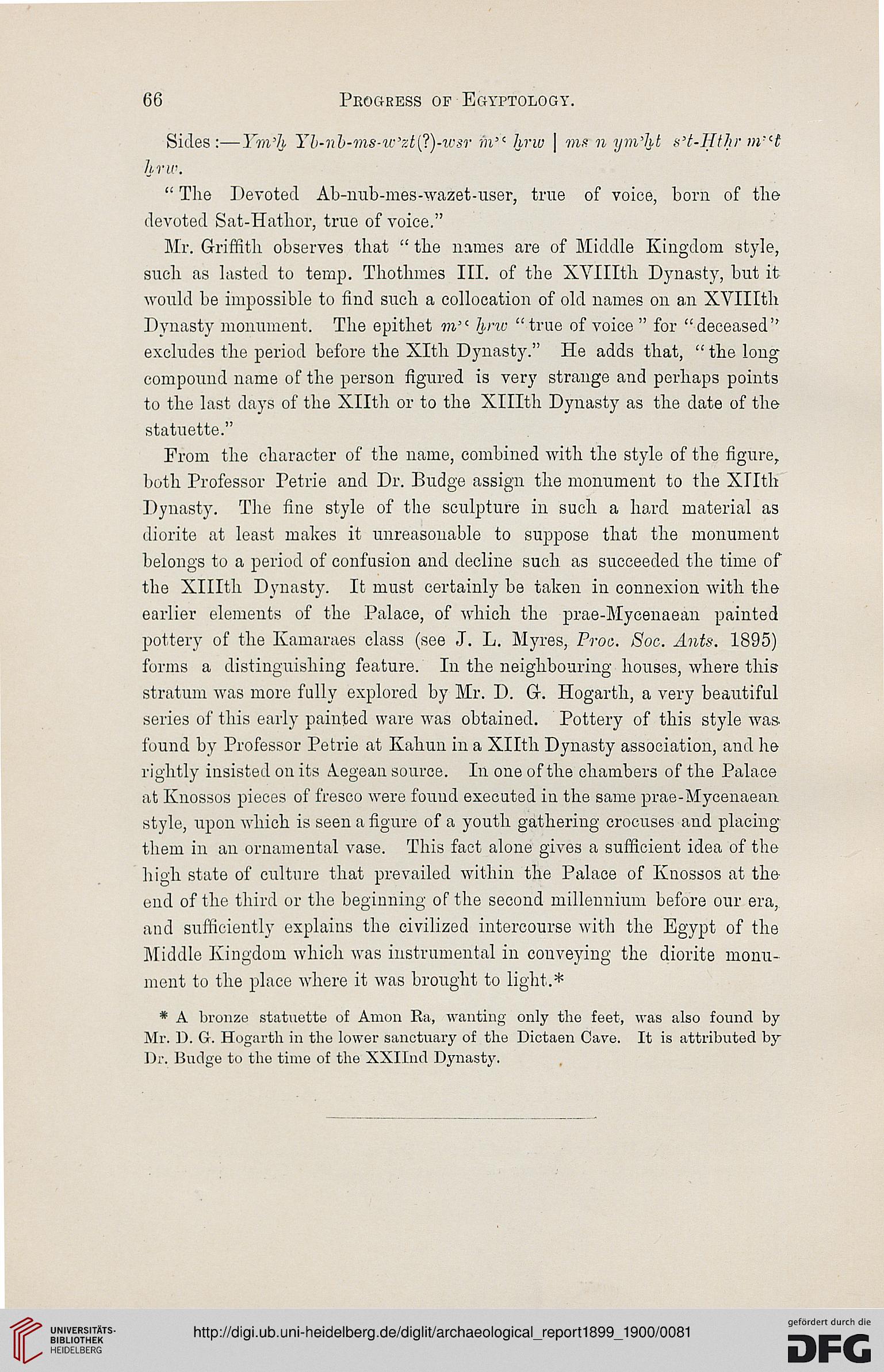66
Progress of Egyptology.
Sides:—Ym'h Yb-nb-ms-w'zt(?)-wsr m'1 hrw \ ms n ym'ht s't-Hthr m'(t
hrw.
"The Devoted Ab-nub-mes-wazet-user, true of voice, born of the
devoted Sat-Hathor, true of voice."
Mr. Griffith observes that " the names are of Middle Kingdom style,
such as lasted to temp. Thothmes III. of the XVIIIth Dynasty, but it
would be impossible to find such a collocation of old names on an XVIIIth
Dynasty monument. The epithet m" hrw "true of voice " for "deceased"
excludes the period before the Xlth Dynasty." He adds that, "the long
compound name of the person figured is very strange and perhaps points
to the last days of the Xllth or to the Xlllth Dynasty as the date of the
statuette."
From the character of the name, combined with the style of the figure,
both Professor Petrie and Dr. Budge assign the monument to the Xllth
Dynasty. The fine style of the sculpture in such a hard material as
diorite at least mahes it unreasonable to suppose that the monument
belongs to a period of confusion and decline such as succeeded the time of
the Xlllth Dynasty. It must certainly be taken in connexion with the
earlier elements of the Palace, of which the prae-Mycenaean painted
pottery of the Kamaraes class (see J. L. Myres, Proo. Soc. Antm. 1895)
forms a distinguishing feature. In the neighbouring houses, where this
stratum was more fully explored by Mr. D. G. Hogarth, a very beautiful
series of this early painted ware was obtained. Pottery of this style was-
found by Professor Petrie at Kahun in a Xllth Dynasty association, and he
rightly insisted on its Aegean source. In one of the chambers of the Palace
at Knossos pieces of fresco were found executed in the same prae-Mycenaean
style, upon which is seen a figure of a youth gathering crocuses and placing
them in an ornamental vase. This fact alone gives a sufficient idea of the
high state of culture that prevailed within the Palace of Knossos at the
end of the third or the beginning of the second millennium before our era,
and sufficiently explains the civilized intercourse with the Egypt of the
Middle Kingdom which was instrumental in conveying the diorite monu-
ment to the place where it was brought to light.*
* A bronze statuette of Amon Ra, wanting only the feet, was also found by
Mr. D. G. Hogarth in the lower sanctuary of the Dictaen Cave. It is attributed by
Dr. Budge to the time of the XXIInd Dynasty.
Progress of Egyptology.
Sides:—Ym'h Yb-nb-ms-w'zt(?)-wsr m'1 hrw \ ms n ym'ht s't-Hthr m'(t
hrw.
"The Devoted Ab-nub-mes-wazet-user, true of voice, born of the
devoted Sat-Hathor, true of voice."
Mr. Griffith observes that " the names are of Middle Kingdom style,
such as lasted to temp. Thothmes III. of the XVIIIth Dynasty, but it
would be impossible to find such a collocation of old names on an XVIIIth
Dynasty monument. The epithet m" hrw "true of voice " for "deceased"
excludes the period before the Xlth Dynasty." He adds that, "the long
compound name of the person figured is very strange and perhaps points
to the last days of the Xllth or to the Xlllth Dynasty as the date of the
statuette."
From the character of the name, combined with the style of the figure,
both Professor Petrie and Dr. Budge assign the monument to the Xllth
Dynasty. The fine style of the sculpture in such a hard material as
diorite at least mahes it unreasonable to suppose that the monument
belongs to a period of confusion and decline such as succeeded the time of
the Xlllth Dynasty. It must certainly be taken in connexion with the
earlier elements of the Palace, of which the prae-Mycenaean painted
pottery of the Kamaraes class (see J. L. Myres, Proo. Soc. Antm. 1895)
forms a distinguishing feature. In the neighbouring houses, where this
stratum was more fully explored by Mr. D. G. Hogarth, a very beautiful
series of this early painted ware was obtained. Pottery of this style was-
found by Professor Petrie at Kahun in a Xllth Dynasty association, and he
rightly insisted on its Aegean source. In one of the chambers of the Palace
at Knossos pieces of fresco were found executed in the same prae-Mycenaean
style, upon which is seen a figure of a youth gathering crocuses and placing
them in an ornamental vase. This fact alone gives a sufficient idea of the
high state of culture that prevailed within the Palace of Knossos at the
end of the third or the beginning of the second millennium before our era,
and sufficiently explains the civilized intercourse with the Egypt of the
Middle Kingdom which was instrumental in conveying the diorite monu-
ment to the place where it was brought to light.*
* A bronze statuette of Amon Ra, wanting only the feet, was also found by
Mr. D. G. Hogarth in the lower sanctuary of the Dictaen Cave. It is attributed by
Dr. Budge to the time of the XXIInd Dynasty.





